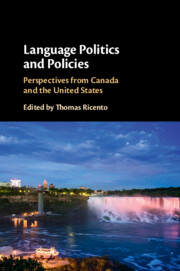Book contents
- Language Politics and Policies
- Language Politics and Policies
- Copyright page
- Dedication
- Contents
- Figures
- Tables
- Contributors
- Preface
- Contributor Personal Statements
- Introduction
- Part I Theoretical Orientations
- Part II The United States Context
- 5 Disciplining Bilingual Education
- 6 Measured Multilingualism
- 7 The Rise, Fall, and Rebirth of Bilingual Education in California and the Ongoing American Dilemma
- 8 Language Policy Conflicts
- 9 Indigenous Language Movements in a Settler State
- 10 The Politics of Language Education Policy Development and Implementation
- Part III The Canadian Context
- Index
- References
5 - Disciplining Bilingual Education
from Part II - The United States Context
Published online by Cambridge University Press: 18 July 2019
- Language Politics and Policies
- Language Politics and Policies
- Copyright page
- Dedication
- Contents
- Figures
- Tables
- Contributors
- Preface
- Contributor Personal Statements
- Introduction
- Part I Theoretical Orientations
- Part II The United States Context
- 5 Disciplining Bilingual Education
- 6 Measured Multilingualism
- 7 The Rise, Fall, and Rebirth of Bilingual Education in California and the Ongoing American Dilemma
- 8 Language Policy Conflicts
- 9 Indigenous Language Movements in a Settler State
- 10 The Politics of Language Education Policy Development and Implementation
- Part III The Canadian Context
- Index
- References
Summary
This chapter argues that disciplining of bilingual education as a scholarly field served to divorce discussions of bilingual education from broader political and economic struggles in favor of the seemingly objective pursuit of the benefits of bilingual education. This disciplining of bilingual education was part of a larger discursive shift that reframed discussions of racial inequality from a focus on unequal access and the need for structural change to a focus on the deficiencies of racialized communities and the need for modifying these deficiencies. The chapter ends with a call for bilingual education scholars to situate issues of language inequality within the broader white supremacist and capitalist relations of power. This will offer bilingual education scholars tools for rejecting deficit perspectives of language-minoritized children and pointing to the broader racial stratification that makes these deficit perspectives possible to begin with.
Keywords
- Type
- Chapter
- Information
- Language Politics and PoliciesPerspectives from Canada and the United States, pp. 97 - 113Publisher: Cambridge University PressPrint publication year: 2019
References
- 1
- Cited by



